










Monastery Chilandar
on Holy Mountain of Athos
in this, 1998 year the Chilandar Monastery celebrates its 800th Anniversary as
the Serbian Orthodox Monastery
| |
| 
Writing and Literature, Culture
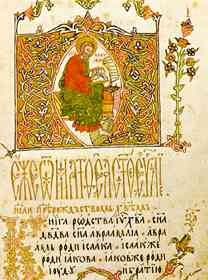
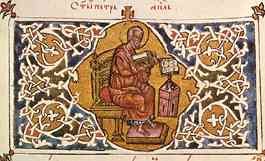
In the Middle Ages the Chilandar Monastery played a major role in spreading of writing
and literature in Serbian lands, certainly in the Serbian variant of Old Slavonic
language. A precondition for the flourishing of literature at Chilandar monastery was the
creation of a library, which has occurred in the 13th century. In Chilandar and
Karyes typika the books are mentioned, and in some later charters. Also, each of
Chilandar's kellia had to have its own library in order to satisfy the basic requirements
of liturgical activity (Gospels, Apostles, Epistles, Liturgiaria, Euchologia, Psalters,
Horologia, Octoechos, Triodion, Pentekostarion, Menaion for feasts), as well as typikon
and synaharion with Saint's Lifes (hagiography), which was read aloud in the refectory. In
Chilandar there are some parchment manuscripts from the 12th and 13th
centuries, as they are: the Karyes typikon with St. Sava's signature, an early copy of the
Chilandar typikon, and many other.
In its rich archives there are 172 Greek, 154 Serbian and two Bulgarian charters from
the Middle Ages. When it is combined with other sources it is possible to reconstruct in
detail the Chilandar's history in the 13th and 14th century. So,
Chilandar may be called as the centre of medieval Serbia's spiritual life and an
intermediary and representative in Serbia's relations with Byzantium.
|
|
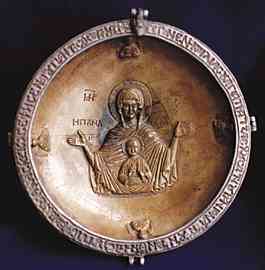 Panagia, 10th or 11th century
|
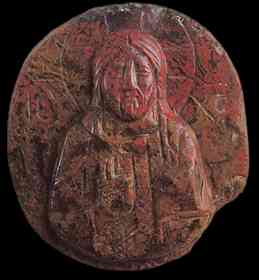 Cameo with the figure of Christ the Pantocraton
early 13th century
|
|
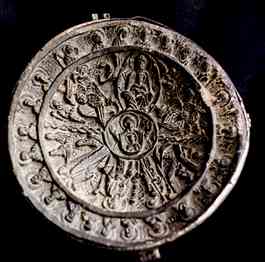 Panagia 13th or 14th century
|
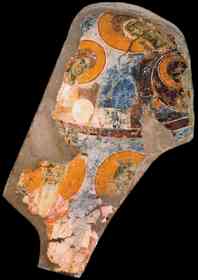 Fresco from the chapter of the Holy Trinity skete
on the saviour's water 1260-70
|
|
|
|
|
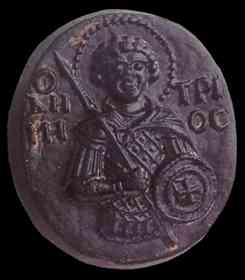 Cameo with the figure of St. Demetrius 13th century
|
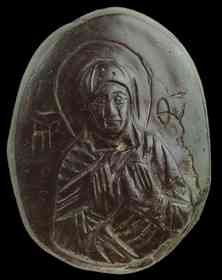 Cameo with the figure of the Virgin 13th century
|
|
The manuscript copying was also one important precondition
for Chilandar to become the main Serbian literary centre in the Middle Ages, which started
as early as in the 13th century, both in the Monastery and in its kellia and
pyrgoi. Theodore Grammaticus was a well-known scribe of the Transfiguration Tower, who was
responsible for the notable Hexaemeron of 1263, which is now in Moscow, Russia. The
greatest Serbian medieval writers were working at Chilandar at that time, such as:
Domentian, who was Theodor's patron and spiritual father. At the end of 13th
century Theodosius lived in Chilandar monastery. The workshop in the Karyes kellion was
very well known during the 14th century. In 1336, the elder Theodulus copied
there the Theodosius's Life of St. Sava. There are also known monk-copiers: Romanus,
Theoctistus, Damian, Job, Dionysius, Joseph, Mark, Athanasius, abbot Dorotheus... This
copying work led to creation of a scriptorium which exerted a great influence on the
morphology of Cyrillic writing in Serbia and played an important role in the development
of Serbian orthography and grammar in the 14th century.
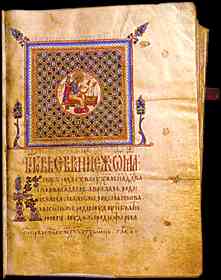 The Fourth Gospels of the
Patriach Sava IV 3th quarter of the 14th century
The Fourth Gospels of the
Patriach Sava IV 3th quarter of the 14th century
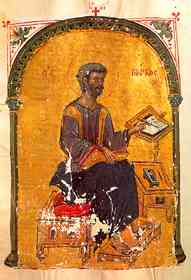 Roman's Gospel 1337, 1360
Roman's Gospel 1337, 1360
The text of St. Simeon's charter on 1198, and of St. Sava's Chilandar typika, served
as the nucleus from which Serbian biographical writing was to develop. St. Sava was both
first Serbian writer of the Nemanjic period and the first Chilandar writer. Very intensive
copying and translating activity at Chilandar monastery has occurred at the end of the
medieval period. The works of the contemporary theologians and hermits of that time were
read and translated, as for instance the works of Gregory Palamas, Gregory of Sinai,
Callistus and many others, etc.
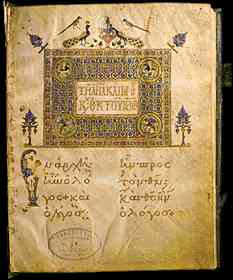 The Evangelistry, late 13th or early 14th century
The Evangelistry, late 13th or early 14th century
|
|

|
|
 
|
